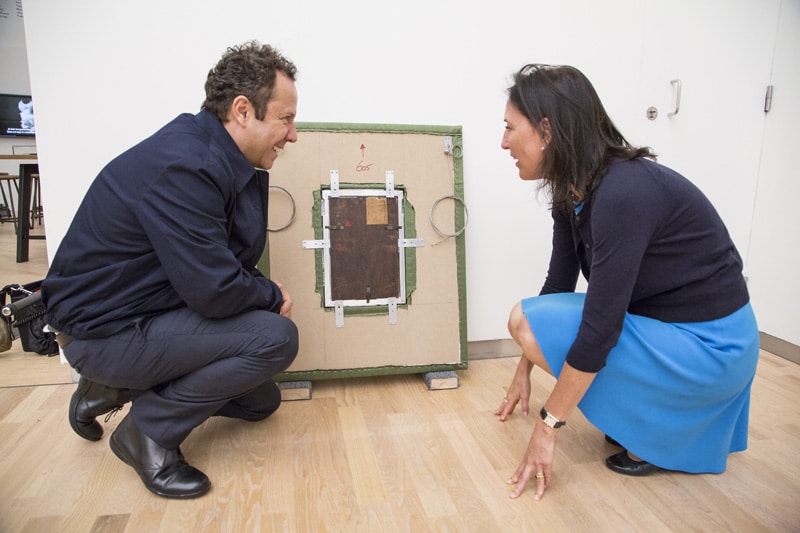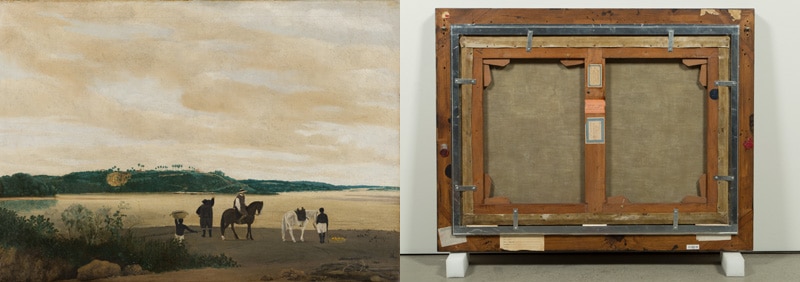Ooit liet Johan Maurits van Nassau-Siegen het Mauritshuis bouwen met geld, verdiend in Brazilië, onder andere in de slavenhandel. Nu exposeert een Braziliaan in datzelfde Mauritshuis met perfecte 3d-replica’s van de achterkant van beroemde schilderijen. Speciaal voor deze tentoonstelling maakte hij er vijf nieuwe. Vier bekende topstukken uit het Mauritshuis, maar ook een schilderij dat betrekking heeft op de Braziliaanse avonturen van toen.
Vik Muniz is een aimabele, uiterst levendige man die weet wat hij wil. Voor directeur Emilie Gordenker even omschakelen: ‘In het Mauritshuis zijn we niet gewend te werken met nog levende kunstenaars, die zelf een mening hebben!’ Muniz, beeldhouwer en fotograaf, wist direct wat hij voor het Mauritshuis wilde maken.

Oude machines op glazen ezels
Als kind groeide hij op met als enige kunst slechte reproducties in de Encyclopedia Brittanica. Een eerste bezoek aan het Museu de Arte de São Paulo op achtjarige leeftijd veranderde zijn wereld. Daar stonden dankzij architect Lina Bo Bardi de schilderijen op glazen ezels de bezoekers toe te lonken, maar Muniz’ echte fascinatie ontstond pas toen hij omkeek. Door het glas heen zag hij nu de achterkanten van de kunstwerken: ‘Als oude machines, met spinnenwebben en andere dingen die kinderen interessant vinden: hout en vreemde onderdelen’.
Naakt
We maken een grote sprong in tijd. Vijftien jaar geleden ziet Muniz, inmiddels kunstenaar, in het Guggenheim New York bij toeval de achterkant van Picasso’s Woman ironing. ‘Het was een beetje alsof ik haar naakt zag. Dus ik vroeg of ik een foto mocht maken, zoals je doet als je een vrouw naakt ziet.’ Een fotoserie van de achterkanten van schilderijen volgde, maar daar bleef het niet bij. Muniz: ‘Als je een idee meteen gebruikt, weerhoud je het ervan te groeien en zich te ontwikkelen.’ Geduld stond dan ook aan de wieg van de Verso’s. Omdat hij de foto’s uiteindelijk saai en levenloos vond, kwam hij op de gedachte trompe l’oeils te maken, reconstructies die niet te onderscheiden zijn van het origineel. Daarbij werkte hij samen met een team om alles tot in de kleinste details te kunnen kopiëren – voor Rembrandts De anatomische les moest een weverij van historische stoffen in de VS het juiste soort canvas namaken.
Muniz: ‘Wie vervalst er nou ooit een achterkant? Niemand! Op het moment dat de voorkant van een schilderij gevernist is, is het de bedoeling dat het nooit meer verandert. De achterkant blijft juist veranderen, wordt een soort paspoort van overal waar het doek geweest is, wat er mee gebeurd is. De voorkant gaat de wereld over, staat op posters, wordt een beeld zonder materialiteit. Bij de achterkant heb ik altijd een gevoel alsof ik aan het gluren ben, als of ik hier niet zou moeten zijn. Veel mensen hebben dat gevoel altíjd als ze een museum bezoeken. Voor het eerst hangen mijn werken nu in musea, waar ook de originele inspiratiebronnen hangen. Dat maakt het verhaal compleet.’

In het Mauritshuis staan de werken met de rug naar de muur. Het is moeilijk voor te stellen dat de voorkanten leeg zijn, net zoals het verbazing wekt dat sommige doeken veel groter of kleiner zijn dan ze aan de voorkant lijken. Picasso’s Woman Ironing is er dus, maar ook Van Goghs Sterrennacht en Leonardo da Vinci’s La Gioconda (Mona Lisa), die laatste voorzien van een ingenieus systeem dat sms-berichten verzendt over iedere verandering in de conditie van het doek.
Rode driehoekjes
Vik Muniz: Verso is een tentoonstelling die je op verschillende manieren kunt bekijken: als kunst, maar ook als historische documentatie van alles wat schilderijen meemaken en als fascinerend inkijkje in de praktijk van het museaal beheer. Wat te denken van de rode driehoekjes, die aangeven welke werken bij een overstroming als eerste geëvacueerd moeten worden?
Van het Mauritshuis vroeg Muniz de achterkanten van vier werken te mogen kopiëren: Johannes Vermeer ’s Meisje met de parel en Gezicht op Delft, Het puttertje van Carel Fabritius en De anatomische les van dr. Nicolaes Tulp van Rembrandt. Op verzoek van het museum maakte hij nog een vijfde kopie: van het Gezicht op het eiland Itamaracá in Brazilië van Frans Post. Johan Maurits ‘de Braziliaan’ gaf persoonlijk opdracht voor dit schilderij. Het verbindt zowel Muniz als het Mauritshuis op een bijzondere manier met hun gemeenschappelijke geschiedenis.

De allervreemdste vondst op de expositie is een eenvoudige sticker. Het Meisje met de parel heeft eigenlijk nog een afdekkende kunststofplaat aan de achterkant, die alles wat interessant is afdekt. Daarom koos Muniz ervoor deze achterkant zonder de kunststof plaat te reproduceren. Dan zou echter onherkenbaar worden om welk schilderij het ging en Muniz wilde absoluut geen bordjes bij de doeken. De oplossing? Een nieuwe sticker op de originele achterkant, en die vervolgens namaken voor de kopie. En ja, wie kopieert dan eigenlijk wie?
Vik Muniz, Verso’s. Mauritshuis, 9 juni tot en met 4 september 2016.
